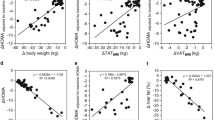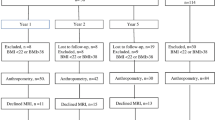Abstract
Aims
The impact of diet-induced weight loss and weight loss due to RYGB in patients with (T2DM, N = 16) and without (OB, N = 27) type 2 diabetes was studied.
Methods
At inclusion (A), after diet-induced weight loss (B), 4 months post-surgery (C) and 18 months post-surgery (D) body composition, hepatic glucose production (HGP), insulin-mediated glucose uptake (GIR), respiratory exchange ratio, hepatic insulin sensitivity and clearance were determined. GLUT4, intramuscular triglycerides (IMTG) and glycogen content were measured in skeletal muscle.
Results
Weight loss was 35–40 kg, and approximately one-third of the total improvement in GIR in T2DM was observed after the diet-induced weight loss of only ~6 kg (B). Insulin clearance, visceral fat and fasting plasma insulin also improved significantly after the diet (P < 0.05). Throughout the study, HGP, GLUT4 and glycogen content did not change significantly, but IMTG decreased significantly consistent with significant increases in GIR. Metabolic flexibility and hepatic insulin sensitivity improved after RYGB.
Conclusions
Metabolic improvements of RYGB are present already after the diet-induced weight loss prior to surgery. GLUT4 content in skeletal muscle cannot and IMTG content can only partly explain increases in GIR after RYGB.



Similar content being viewed by others
Abbreviations
- GIR:
-
Glucose infusion rate
- HGP:
-
Hepatic glucose production
- HISI:
-
Hepatic insulin sensitivity index
- IMTG:
-
Intramuscular triglyceride
- OB:
-
Patients without type 2 diabetes
- RER:
-
Respiratory exchange ratio
- RYGB:
-
Roux-en-Y gastric bypass
- T2DM:
-
Patients with type 2 diabetes
References
Schauer PR, Bhatt DL, Kirwan JP et al (2014) Bariatric surgery versus intensive medical therapy for diabetes—3-year outcomes. N Engl J Med 370:2002–2013
Brethauer SA, Aminian A, Romero-Talamas H et al (2013) Can diabetes be surgically cured? long-term metabolic effects of bariatric surgery in obese patients with type 2 diabetes mellitus. Ann Surg 258:628–636
Bojsen-Moller KN, Dirksen C, Jorgensen NB et al (2014) Early enhancements of hepatic and later of peripheral insulin sensitivity combined with increased postprandial insulin secretion contribute to improved glycemic control after Roux-en-Y gastric bypass. Diabetes 63:1725–1737
Camastra S, Gastaldelli A, Mari A et al (2011) Early and longer term effects of gastric bypass surgery on tissue-specific insulin sensitivity and beta cell function in morbidly obese patients with and without type 2 diabetes. Diabetologia 54:2093–2102
Dunn JP, Abumrad NN, Breitman I et al (2012) Hepatic and peripheral insulin sensitivity and diabetes remission at 1 month after Roux-en-Y gastric bypass surgery in patients randomized to omentectomy. Diabetes Care 35:137–142
Kashyap SR, Daud S, Kelly KR et al (2010) Acute effects of gastric bypass versus gastric restrictive surgery on beta-cell function and insulinotropic hormones in severely obese patients with type 2 diabetes. Int J Obes 34:462–471
Umeda LM, Silva EA, Carneiro G, Arasaki CH, Geloneze B, Zanella MT (2011) Early improvement in glycemic control after bariatric surgery and its relationships with insulin, GLP-1, and glucagon secretion in type 2 diabetic patients. Obes Surg 21:896–901
Dogan K, Betzel B, Homan J et al (2014) Long-term effects of laparoscopic Roux-en-Y Gastric Bypass on diabetes mellitus, hypertension and dyslipidaemia in morbidly obese patients. Obes Surg 24(11):1835–1842
Gregor MF, Yang L, Fabbrini E et al (2009) Endoplasmic reticulum stress is reduced in tissues of obese subjects after weight loss. Diabetes 58:693–700
Halperin F, Ding SA, Simonson DC et al (2014) Roux-en-Y gastric bypass surgery or lifestyle with intensive medical management in patients with type 2 diabetes: feasibility and 1-year results of a randomized clinical trial. JAMA Surg 149:716–726
Pan DA, Lillioja S, Kriketos AD et al (1997) Skeletal muscle triglyceride levels are inversely related to insulin action. Diabetes 46:983–988
Gray RE, Tanner CJ, Pories WJ, MacDonald KG, Houmard JA (2003) Effect of weight loss on muscle lipid content in morbidly obese subjects. Am J Physiol Endocrinol Metab 284:E726–E732
Mingrone G, Rosa G, Greco AV et al (2003) Decreased uncoupling protein expression and intramyocytic triglyceride depletion in formerly obese subjects. Obes Res 11:632–640
Greco AV, Mingrone G, Giancaterini A et al (2002) Insulin resistance in morbid obesity: reversal with intramyocellular fat depletion. Diabetes 51:144–151
Friedman JE, Dohm GL, Leggett-Frazier N et al (1992) Restoration of insulin responsiveness in skeletal muscle of morbidly obese patients after weight loss. Effect on muscle glucose transport and glucose transporter GLUT4. J Clin Invest 89:701–705
Steele R (1959) Influences of glucose loading and of injected insulin on hepatic glucose output. Ann NY Acad Sci 82:420–430
Insel PA, Liljenquist JE, Tobin JD et al (1975) Insulin control of glucose metabolism in man: a new kinetic analysis. J Clin Invest 55:1057–1066
Cowan JS, Hetenyi G Jr (1971) Glucoregulatory responses in normal and diabetic dogs recorded by a new tracer method. Metabolism 20:360–372
Steele R, Wall JS, de Bodo RC, Altszuler N (1956) Measurement of size and turnover rate of body glucose pool by the isotope dilution method. Am J Physiol 187:15–24
Diabetes trials unit, The Oxford Centre for Diabetes Endocrinology and Metabolism. HOMA calculator. 2014. (GENERIC). Ref Type: Online Source
Abdul-Ghani MA, Matsuda M, Balas B, DeFronzo RA (2007) Muscle and liver insulin resistance indexes derived from the oral glucose tolerance test. Diabetes Care 30:89–94
Matsuda M, DeFronzo RA (1999) Insulin sensitivity indices obtained from oral glucose tolerance testing: comparison with the euglycemic insulin clamp. Diabetes Care 22:1462–1470
Ferrannini E, Wahren J, Faber OK, Felig P, Binder C, DeFronzo RA (1983) Splanchnic and renal metabolism of insulin in human subjects: a dose-response study. Am J Physiol 244:E517–E527
Frayn KN (1983) Calculation of substrate oxidation rates in vivo from gaseous exchange. J Appl Physiol Respir Environ Exerc Physiol 55:628–634
Gram M, Vigelso A, Yokota T et al (2014) Two weeks of one-leg immobilization decreases skeletal muscle respiratory capacity equally in young and elderly men. Exp Gerontol 58C:269–278
Folch J, Lees M, Stanley HS (1957) A simple method for the isolation and purification of total lipids from animal tissues. J Biol Chem 226:497–509
Johansson L, Roos M, Kullberg J et al (2008) Lipid mobilization following Roux-en-Y gastric bypass examined by magnetic resonance imaging and spectroscopy. Obes Surg 18:1297–1304
Sinha R, Dufour S, Petersen KF et al (2002) Assessment of skeletal muscle triglyceride content by (1)H nuclear magnetic resonance spectroscopy in lean and obese adolescents: relationships to insulin sensitivity, total body fat, and central adiposity. Diabetes 51:1022–1027
Hoeg L, Roepstorff C, Thiele M, Richter EA, Wojtaszewski JF, Kiens B (2009) Higher intramuscular triacylglycerol in women does not impair insulin sensitivity and proximal insulin signaling. J Appl Physiol 107:824–831
Vistisen B, Hellgren LI, Vadset T et al (2008) Effect of gender on lipid-induced insulin resistance in obese subjects. Eur J Endocrinol 158:61–68
Donahue RP, Prineas RJ, DeCarlo DR, Bean JA, Skyler JS (1996) The female ‘insulin advantage’ in a biracial cohort: results from the Miami community health study. Int J Obes Relat Metab Disord 20:76–82
Kelley DE, Goodpaster B, Wing RR, Simoneau JA (1999) Skeletal muscle fatty acid metabolism in association with insulin resistance, obesity, and weight loss. Am J Physiol 277:E1130–E1141
Pereira JA, Lazarin MA, Pareja JC, de Souza A, Muscelli E (2003) Insulin resistance in nondiabetic morbidly obese patients: effect of bariatric surgery. Obes Res 11:1495–1501
Immonen H, Hannukainen JC, Iozzo P et al (2014) Effect of bariatric surgery on liver glucose metabolism in morbidly obese diabetic and non-diabetic patients. J Hepatol 60:377–383
Lund MT, Hansen M, Skaaby S et al (2015) Preoperative beta-cell function in patients with type 2 diabetes is important for the outcome of Roux-en-Y gastric bypass surgery. J Physiol 593(14):3123–3133
Acknowledgments
Technical assistance from Jeppe Bach, Thomas Bech, Christina Neigaard Hansen, Katrine Qvist and Regitze Kraunsøe (Xlab, Center for Healthy Aging, Department of Biomedical Sciences, University of Copenhagen) is gratefully acknowledged. Sina Dalby, Emilie Hansen, Lærke Taudorf and Stinna Skaaby (Xlab, Center for Healthy Aging, Department of Biomedical Sciences, University of Copenhagen) are thanked for helping with recruitment and test days. The nurses Lisette Lind Larsen and Anne-Lise Mortensen (Department of Surgery, Koege Hospital) are thanked for their help. Annette Svenningsen, MD, and surgeon Andrea Karen Floyd (Koege Hospital) are thanked for the recruitment of the first patients. Lene Foged (Clinical Metabolism, Department of Biomedical Sciences, University of Copenhagen) is acknowledged for isotope analysis. We thank all the subjects who participated in the study for their cooperation.
Funding
The financial support from the Innovation Fund Denmark (0603-00381B), the Nordea Foundation, Kathrine and Vigo Skovgaards Foundation and Simon Fougner Hartmann Family Foundation is gratefully acknowledged.
Contribution statement
M.H. performed clinical study, researched data and wrote the manuscript. M.T.L. performed clinical study, researched data and reviewed the manuscript. A.L.J./M.P. performed clinical study. G.v.H. advised on isotopes and contributed to results and discussion. J.W.H. researched data and reviewed/edited the manuscript. F.D. designed the study, researched data and reviewed/edited the manuscript. M.H. is the guarantor of this work and, as such, had full access to all the data in the study and takes responsibility for the integrity of the data and the accuracy of the data analysis.
Author information
Authors and Affiliations
Corresponding author
Ethics declarations
Conflict of interest
The authors declare that they have no conflict of interest.
Human and animal rights statement
All procedures were followed in accordance with the ethical standards of the responsible committee on human experimentation (institutional and national) and were carried out in accordance with the Declaration of Helsinki as revised in 2008 and approved by the local ethics committee of Copenhagen (Protocol: H-C-2009-050).
Informed consent
All patients gave informed written consent.
Additional information
Managed by Massimo Federici.
Rights and permissions
About this article
Cite this article
Hansen, M., Lund, M.T., Jørgensen, A.L.K. et al. The effects of diet- and RYGB-induced weight loss on insulin sensitivity in obese patients with and without type 2 diabetes. Acta Diabetol 53, 423–432 (2016). https://doi.org/10.1007/s00592-015-0812-2
Received:
Accepted:
Published:
Issue Date:
DOI: https://doi.org/10.1007/s00592-015-0812-2




